Through Data File and Datasheets
Specify Data File
By using the -data command-line option, we can override the above convention. For example,
./nexial.sh -script $MY_PROJECT_HOME/artifact/script/DifferentDataFile.xlsx -data /Users/me/data/QA/AnotherDataFile.xlsx
Nexial will use the fully qualified data file, as specified, instead of the conventional data file. However one can
also simplify the above command-line option by omitting the fully qualified location of the target data file:
./nexial.sh -script $PROJECT_HOME/artifact/script/DifferentDataFile.xlsx -data AnotherDataFile.xlsx
When the precise location of AnotherDataFile.xlsx is not specified, Nexial searches through these locations
(order precedence):
$PROJECT_HOME/artifact/script$PROJECT_HOME/artifact/data$PROJECT_HOME/artifact
Let’s see this feature in action. Here’s the automation script (artifact/script/DifferentDataFile.xlsx):

We have AnotherDataFile.xlsx located in artifact/data:
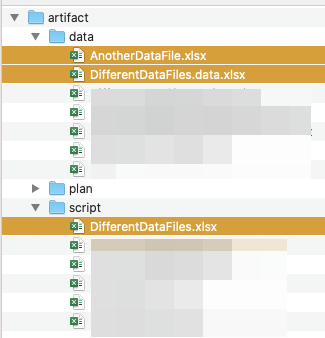
The content of AnotherDataFile.xlsx looks like this:
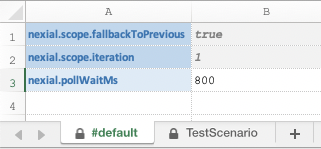
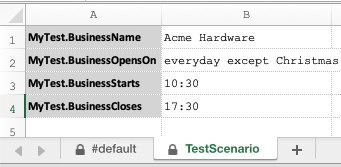
As the execution output shows (below), Nexial is now using the data defined in artifact/data/AnotherDataFile.xlsx:

Specifying Datasheets
Nexial provides the ability to alter the default convention via the -datasheets command-line option.
Suppose we have 2 other datasheets in the same data file:
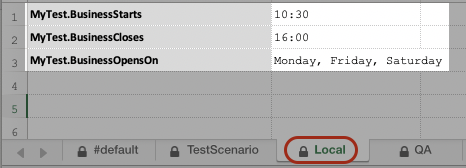
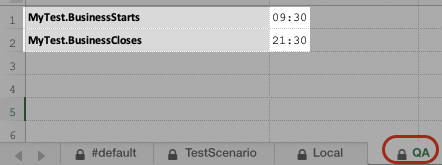
We can specify the use of these datasheets via command-line option:
./nexial.sh -script $MY_PROJECT_HOME/artifact/script/MyTest.xlsx -datasheets Local,QA
Now Nexial will not consider the data variables defined in TestScenario. The sequence of data variable resolution
would now be:
- Load data variables defined in
#default - Load data variables defined in
Local, possibly overriding previously defined ones - Load data variables defined in
QA, possibly overriding previously defined ones
NOTE: “The last one WINS!”
Since ${MyTest.BusinessStarts} is defined in the #default, Local and QA datasheets, the one defined in QA
datasheet will take effect because the QA datasheet is the last one to load. Now observe the execution output:

The value of the referenced data variables are as follows:
${MyTest.BusinessStarts}–>09:30(fromQAdatasheet)${MyTest.BusinessCloses}–>21:30(fromQAdatasheet)${MyTest.BusinessOpensOn}–>Monday, Friday, Saturday(fromLocaldatasheet)
Suppose we switch the order of the datasheets from Local,QA to QA,Local. What do you think the output would look
like?

In this case, the value of referenced data variables are as follows:
${MyTest.BusinessStarts}–>10:30(fromLocaldatasheet)${MyTest.BusinessCloses}–>16:00(fromLocaldatasheet)${MyTest.BusinessOpensOn}–>Monday, Friday, Saturday(fromLocaldatasheet)
Combing the use of -data and -datasheet
We can combine the use of both -data and -datasheet to device a flexible and extensible way of handling
environment-specific data. Consider the following examples:
Running “happy path” with the “good data” that is valid in “QA”:
./nexial.sh -script $MY_PROJECT_HOME/artifact/script/HappyPath.xlsx -data QA.xlsx -datasheet Good-Data
Running “happy path” with expected data in “QA”, first use “last quarter” data and then override with “this quarter”:
./nexial.sh -script $MY_PROJECT_HOME/artifact/script/HappyPath.xlsx -data QA.xlsx -datasheet LastQuarter,CurrentQuarter
Running the error conditions with the “outdated orders” found in the “QA” environment:
./nexial.sh -script $MY_PROJECT_HOME/artifact/script/Exceptions.xlsx -data QA.xlsx -datasheet OutdatedOrder
Running the error conditions in “UAT”, using first the data from “last month” and then overload with data from “this
month”:
./nexial.sh -script $MY_PROJECT_HOME/artifact/script/Exceptions.xlsx -data UA.xlsx -datasheet LastMonth,ThisMonth
Conclusion
The ability to load unconventional datasheets during execution gives us flexibility and control over the
automation data set. One can achieve via the -datasheet command-line option. One can design an environment-specific
dataset via dedicated datasheets. One can also design a “default” datasheet to maintain the environment-agnostic dataset
(consider the #default datasheet for this) to further simplify the maintenance of data variables.
The ability to use different data file during execution gives us more coarse-grained control over our data set. One can
design segregated sets of data - and potentially each with different ownership - for each environment. When used in
combination with the -datasheet command-line option, we can achieve even greater flexibility and control over the
environment-specific data.